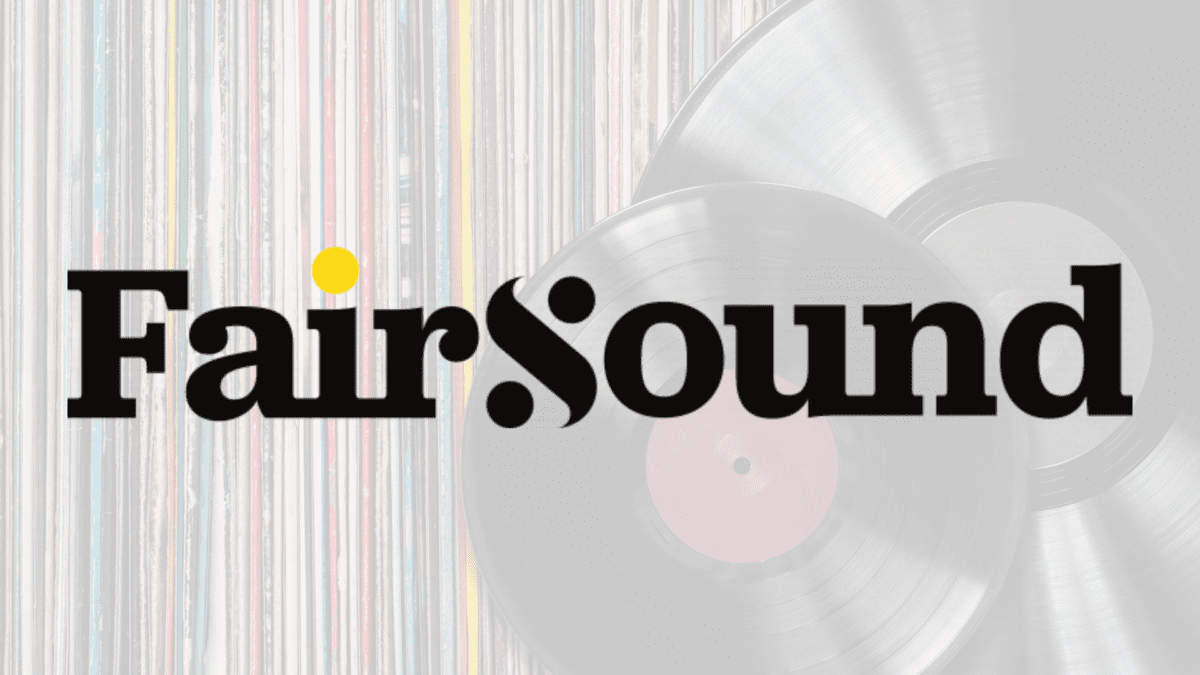Whether you are wondering what a drum machine is, or looking for the perfect machine for you, this article is for you. Have you ever wondered how to find a drum machine that suits your ability, price range, and is easy to buy? There are thousands of drum machines out there, and finding one that fits your needs can be tricky. Here, we will look at some of the best drum machines out there, which range in size, price, and features, and then look at how we can find the best drum machine for you.
What Is A Drum Machine?

You may be asking, what is a drum machine and why should I buy one?
In its simplest form, a drum machine is a piece of musical hardware built to imitate percussive sounds. They have an abundance of sounds, which vary from acoustic mimics to electronic samples. When you buy a drum machine, you gain access to dozens of sounds and hundreds of beats at the push of a button. You may want some inspiration, or want to create beats quickly. Either way, a drum machine is the perfect tool for the job. You can also access apps which emulate online drum machine, which I will also look at.
A Brief History
The first rhythm box created is arguably one of the most iconic. The Roland CR-78 drum machine, launched in 1978, held 14 sounds, with 64 preset rhythms. This machine pioneered a new way of creating drum grooves. It quickly featured on classic tracks such as, ‘In The Air Tonight’ by Phil Collins, ‘Atomic’ by Blondie, and so many more!
The CR-78’s successor had a big pair of shoes to fill. This task was not for the faint-hearted, yet Tadao Kikumoto and his team produced not only one of the most quintessential drum machines in history but produced a new approach to creating the sounds. This is the same methodology used to this day. You probably could have guessed it… it is the TR-808 (also known as the iconic ‘808 drum machine’).
The TR 808 Drum Machine

Launched in 1980, the TR-808 was built to produce realistic sounds through the use of analog synthesizers. Yet, for most people, the 808 drum machine sound was more synth than realistic. The pinnacle moment wasn’t the launch of this iconic drum machine, but rather the decision to choose analog production over digital.
For the composer, the TR-808 was easy to use, and showed great potential. But this revolutionary machine was discontinued after a mere two years. With only 12,000 units sold, the commercial world deemed it a failure. This is ironic looking back, as musicians today are still using it, and it is seen to be one of the most epochal drum machines to be made!
What Next?

After Roland’s so-called flop, Roger Linn launched the LinnDrum. It flipped Roland’s analogue mentality to the reign of digital samples. Focusing on realism rather than the futuristic sounds of the 808, it was accepted on a wider level. I guess in the early eighties, people weren’t ready for synthetic sounding drum machines, and preferred to groove to a more realistic, ‘acoustic’ imitation.
Yet, that didn’t stop Roland from having another go. Maintaining an analog approach, Roland was set on the use of drum synthesizers, rather than digital playback. Finally, they realized that listeners just weren’t ready to commit to such sounds. Here, the TR-909 was born. Roland compromised by using digital recordings for the hi-hats and cymbals, whilst using analog for the kick and toms, meaning you could alter the kick and tom tunings. This combined to form unique sounds that were more widely accepted by beatmakers.
These machines are hard to find and expensive. Fortunately, we live in a time where we have access to a multitude of drum machines ranging in price, timbre, and size. Most importantly, these machines are far easier to find and purchase, meaning there is something for everyone!
Key Factors To Consider When Choosing A Drum Machine

Before breaking down some of the best drum machines and drum machine online, we must identify the key factors that combine to make a great machine.
Timbre
Derived from the word ‘tympanum’, timbre is the character or quality of a musical sound or voice as distinct from its pitch and intensity. Even drum machines are distinct in tone, pitch, and all things sound.
Budget
As well as this, we are all quick to think about the budget! So, what is the cut off point at which you just can’t justify the spend? When considering this, weigh up the benefits. How often will you be using the machine? If it is all the time (i.e. if you love to make beats), is it worth a bigger investment? Another key factor to consider is the income that it could provide, like the tracks you build from it which could be sold. Instruments are investments, so for the beginner, why not invest a little time and money, and try it out for yourself? For the more experienced beatmaker, maybe this article will pinpoint the exact machine for you, or give you the tools needed to find the perfect one.
Type
Next is the type of machine. Yes, they are all drum machines, but they do not all come in a big box! The cheapest and most accessible option is apps. They range in price and compatibility. Whether you want a fully automated app, or one in which you can edit individual notes, there is a wide range of options. However, you may want a physical electronic instrument. Some of these drum machines are built to emit sound, and others are built as recording instruments. They vary in size and weight, as well as how many sounds they provide.
Best App Drum Machines
Now that we have looked at the key factors, let’s take a look at my top picks for the best drum machine apps available:
1. Beat-Machine
Free – iOS

This app is super simple to use, but is far from basic.
With a drum machine pad and sequencer layout, whether you like to play your beats in, or draw them in instead, this app functions in both ways. There is also a mixing desk, which allows you to adjust the levels of each sample and adjust basic EQ parameters. One of the main features that make it stand out is its MIDI function and compatibility with Ableton live (through its function ‘Link’). This feature allows you to play with other Link-enabled apps that are on the same network. This means that you can sync MIDI, their clocks, and link multiple devices to both receive and send MIDI notes. To top it off, you can also allocate specific MIDI notes to pads.
You can also change the look of the machine with colorful alternatives, save your beats, and string them together in ’song mode’ whilst also changing each instrument by adjusting parameters. These parameters include:
- Pitch
- Drive
- ADSR (attack, decay, sustain, release)
- Cutoff filter
- Sample rate and bit depth
With sixteen pads, multiple time signatures and a huge library of both new and vintage samples, this app is incredible. Did I mention it’s completely free?
Ratings: 4.5/5
2. EGDR909
£3.99 – iOS and android
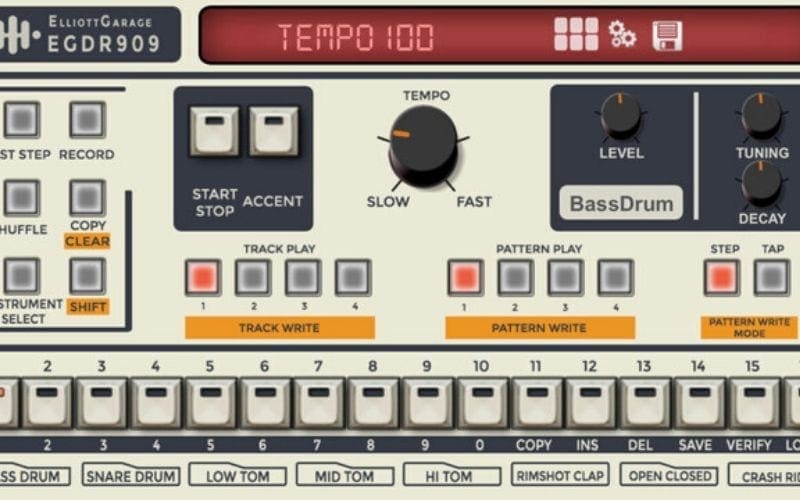
This app has three other very similar apps that feature other iconic machines like the TR-808, TR-606, and LM-1. You can use the EDGR909 and EDGR808 for free, but to unlock features like song mode, the ability to save and export grooves, and MIDI compatibility, you have to buy the full version for £3.99… Or, you could buy the entire bundle, and access the broad range of sounds for £13.99.
Other than that, they sound somewhat similar to the iconic machines and look similar in style. With both a pad and draw mode, you can create grooves or choose a preset and jam along to the 16-step sequencer. Like the Beat-Machine, you can also control the sound’s pitch and decay, whilst adapting your beat by swinging it and changing its tempo.
Ratings: 4.5/5
3. BeatHawk
£9.99 – iOS
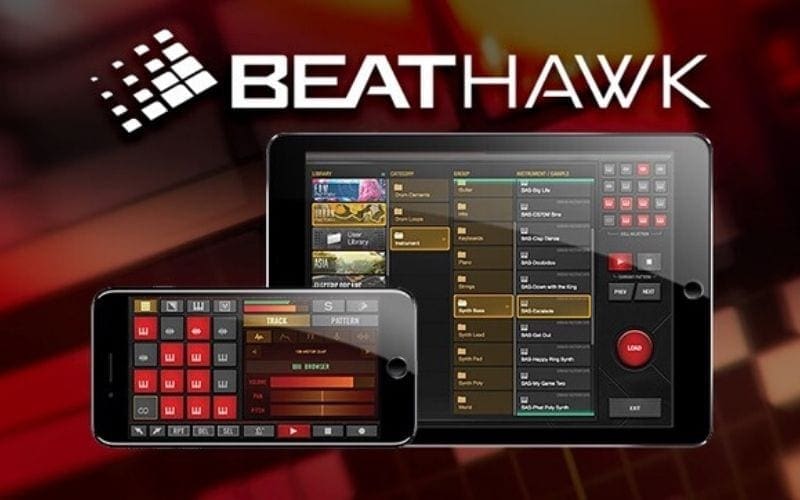
The BeatHawk is made up of UVI sounds, which have over 2,000 samples, 290 presets, and dozens of loops. You can also import and record your own samples using a built-in microphone, line-in or external device. It also records beats using the 16 part sequencer, and saves up to 16 patterns per part. You can also perform and record in real time. As well as the classic step sequencer, there is also a keyboard and drum pad machine mode, allowing you to create complete compositions. Here, you can loop and one-shot your samples.
This app is extremely versatile and accessible with its easy to use pitch and time-stretching features. Meanwhile, you can also edit samples with the array of effects and envelopes it has. Above all else, this app allows you to export your work quickly and in multiple formats. Whether you want to export your mixes, stems, midi tracks or even in the form of Ableton Live project files, it is easy, and helps you quickly transfer your creations to your DAW. Finally, this app gains you quick upload access to YouTube and Soundcloud, making it easy to get your work out there for the world to hear.
Ratings: 4.5/5
Honorable mentions: Remix Live (Free – iOS and Android) and Beat Maker 2 (£11.99 – iOS)
Best Drum Machine
Next up are the best drum machines! Here are my picks for the best physical drum machines available:
1. KORG Volca Drum
£119 at Kytary
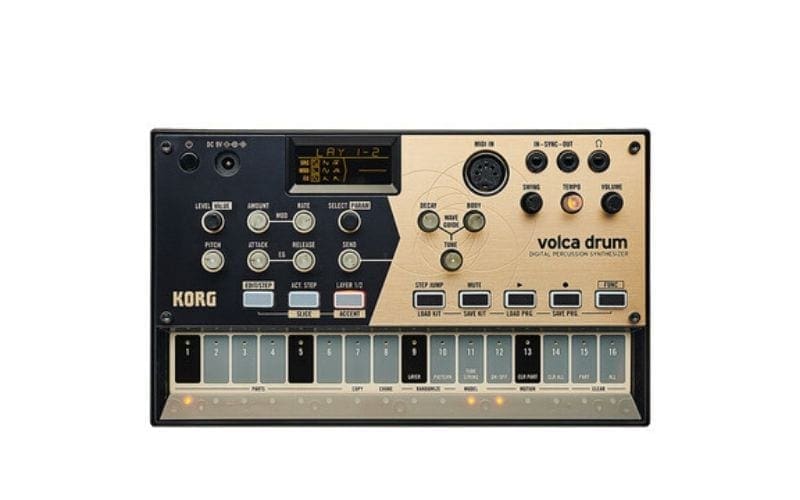
For something so compact, with built-in speakers and battery operation, this machine is by far the best for your money.
It incorporates both percussive sounds and synthesizers over 6 parts with a 2 layer structure. Here, you can adjust each layer’s attack, release and accentuation, which comes with 16 levels. You can also model the effects of a tube or string, and still be able to change the sounds pitch, decay and body. With its custom LCD screen, you can see and change the sound’s waveform. This six-part DSP synth engine is unique in the versatile sounds it offers.
As for its rhythmic features, the Korg Volca Drum has a slicing effect, which allows you to create rolls. It also has a swing effect, which creates a dotted feel. It has two randomizers which can be swapped out for the step editor (where you create beats). As well as recording live, you can also record motion, which is the automation of your selected instrument and parameter. You can save up to sixteen kits, and beats, and can chain them together. With a MIDI output, this machine makes it easy to record, and allows for synchronized performances with DAW’s and other Volca units.
With a MIDI clock, the Volca follows tempo changes and ensures your rhythms stay on time. I love this machine, as it is compact and easy to work with, whilst being extremely versatile. For around £120, it is a bargain and is an easy transition into the drum machine world.
Ratings: 4.7/5
2. Rhythm Designer RD-8 Drum Machine
£273 at Bax Music
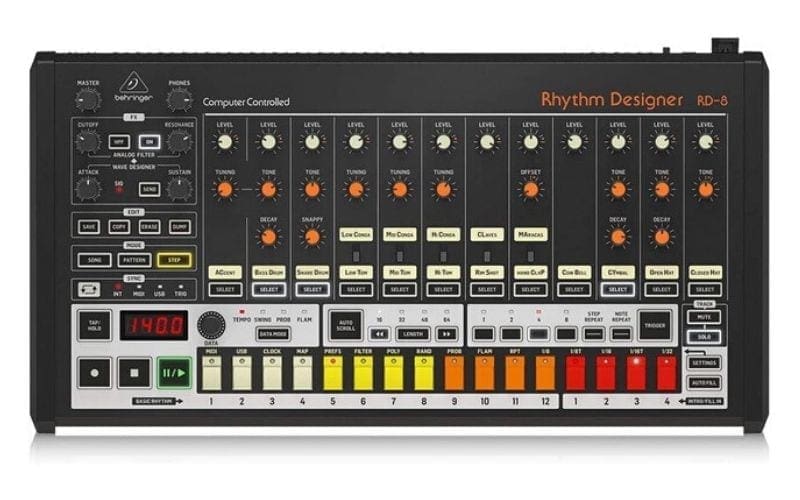
This machine is a grand tribute to the TR-808. It boasts sixteen drum sounds, corresponding outputs, and individual level adjustment.
This machine is the definition of user-friendly. With both midi and USB connectivity, it is easy to record and is fully compatible with the MIDI clock. Whilst being an analog drum machine, it also has three trigger outputs, allowing you to control external synths and sequencers. Similarly to the Korg Volca Drum, you can adjust the attack, decay, sustain, tuning, tone, and more with the inbuilt analog filter. It has both a sixteen-step sequencer and a pattern mode, with a song feature which means you can string together your beats. You may want a straight groove, or with this machine, a swung feel. It offers both live recording and playback editing, whilst storing up to 16 songs and 256 patterns, which can be both imported and exported during playback. This is a great hybrid of the best of the past, and what we hope for the future!
Ratings: 4.5/5
3. Teenage Engineering PO-32

It may be small in size, but the PO-32 Tonic does almost as much as the two previous machines for a fraction of the size and price.
With an inbuilt microphone, this drum machine is user-friendly and easy to transport. It can record both live and through the sixteen-step sequencer, but it is just as versatile through its accessible yet diverse effects. There are a total of 16 effects ranging from distortion, squash, and sweeps, to FM, reverse, granular and more. These are on top of the staple effects found in most drum machines, like the ability to adjust accents, tempo, and swing.
With 16 default drum and percussion sounds, you can adapt this device to suit the style and sounds you want by entirely replacing each sound in each slot using Sonic Charge’s Microtonic Plugin. This allows you to create electronic percussion. You also can both store and chain together patterns, whilst also being able to export and store patterns on any recording device. This can be done via the line out, which also acts as a way of syncing multiple devices together, increasing your pattern capacity. This makes this device almost as cool as the animations that feature on its LCD screen.
Ratings: 4.9/5
Honourable mentions: Elektron Digitakt (£629 at Andertons Music) and Arturia DrumBrute (£260 at Bax Music).
Final Thoughts On Drum Machine
These are just my recommendations, but they may not suit you! So, go and check out the market and do some research. Hopefully, the tools and components we’ve talked about will give you a head start or a flicker of interest when choosing the right drum machine for you. Now you have hopefully seen an app or machine that you want to try out, and will be utilizing your new machine in your music!









